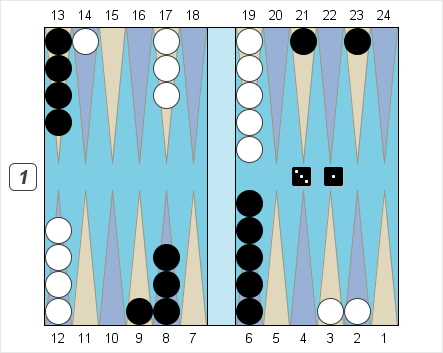
Black – Pips 159 (-3)
Black to Play 3-1
(A) Cash game, center cube.
(B) Tournament match, double match point.
(C) Tournament match, Black trails 3-4 to 5, Crawford Game.
(D) Tournament match, Black leads 4-3 to 5, Crawford Game.
When you have a choice between constructive plays, the cube position and match score may determine the play you make, even when no cube turn is imminent. Keep these guidelines in mind:
(1) Making a point in your inner board will increase your chance of winning a gammon.
(2) Making a defensive anchor will decrease your chance of losing a gammon.
(3) Making an aggressive inner point instead of a defensive anchor will result in more gammons for both sides. The volatility of the position will increase.
(4) Escaping back checkers and cleaning up blots will, in general, increase your winning chances while decreasing gammon chances for both sides. The volatility of the position will decrease.
All these ideas come into play in money games to a small degree as we try to balance winning chances and gammon chances to determine the best move. In tournament matches, however, they play a much bigger role. Depending on the score, gammons may be hugely important or completely irrelevant.
Now let’s look at our actual problem.
In (A), we just need the best play for money. Here it should be pretty clear that 8/5 6/5 will dominate the other choices. Making the 5-point leaves Black with a good distribution and helps unstack his 6-point. White has a 6-shot to hit on the 9-point, but 6-1, 6-3, and 6-4 play well already, so that’s not as costly as it might be. Since White’s men aren’t anchored, the 5-point sets up a potential attack in the future. Making the 20-point is good for defense, but White has no board and not a lot of threats, so defense isn’t a high priority here.
In (B), we’re in a tournament game with a double match point situation. We can’t win a gammon, and we also can’t lose one, so a couple of our choices drop off the radar screen. The double-hit (6/3*/2*) is weak positionally, and its only merit is as a gammon play. Toss that in the garbage. Making the 20-point anchor is great for preventing gammons, but we preferred making the 5-point even when gammons counted, so that goes away as well. We’re left with making the 5-point and the passive 13/9. Normally making the 5-point would be a clear winner, but the importance of not losing ground in the race and the unimportance of gammons at DMP brings 13/9 up to a tie for first. This is a somewhat surprising result for most players, and one well worth noting. Double match point is much more of a straightforward racing game than other forms of backgammon.
In (C) we need two points to win the match in the Crawford game, while our opponent just needs to win this game to win the match. This situation is known by the term gammon-go. In money games, turning a single win into a gammon gains half as much as preventing a win from turning into a loss; here the ratio is 1-to-1, so Black is much more eager to seek out gammons.
But what’s the right play for winning a gammon? Obviously making the 20-point or playing 13/9 drop out of contention. Interestingly, making the 5-point is much better than the double-hit; it both wins more games and more gammons. Playing 6/3*/2* with no board is just a weak play, the only play among the four which isn’t best at any score.
In (D), we’re in the opposite situation, known as gammon-save: we just need to win a single game, while a gammon for our opponent wins the match. As you’d expect, the simple 23/20 21/20 becomes the winner here. Nailing down the best possible anchor reduces gammons to a minimum while still making Black an overall favorite to win.
Solutions:
(A) Money: 8/5 6/5
(B) Double match point: (tossup) 13/9 or 8/5 6/5
(C) Gammon-go: 8/5 6/5
(D) Gammon-save: 23/20 21/20





